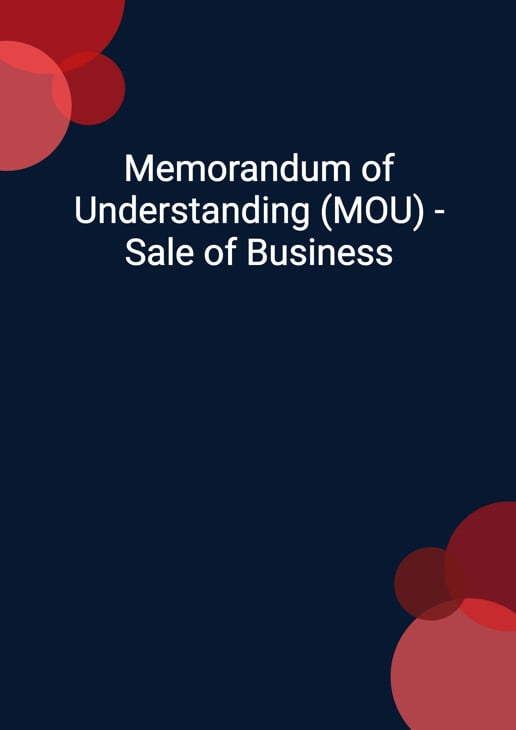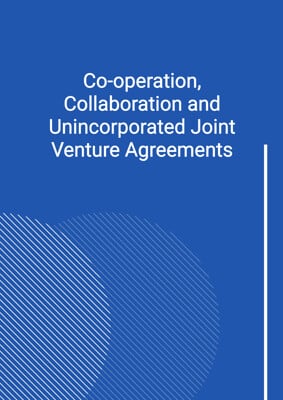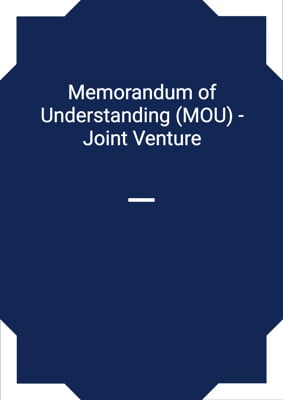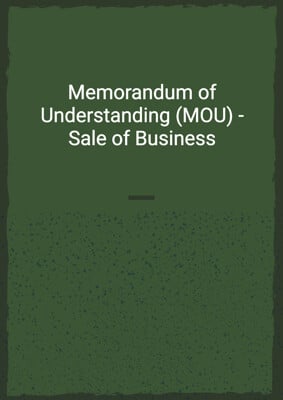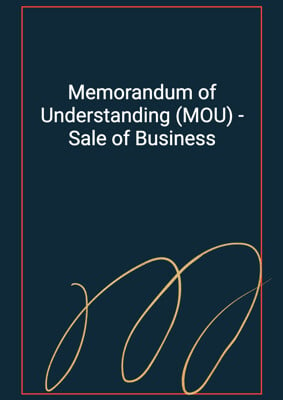How to Tailor the Document for Your Need?
01
Create Document
Fill in the details of the parties. You can click the "Fill with Member’s Information" button to complete it with information saved to your account.
02
Fill Information
Please fill in any additional information by following the step-by-step guide on the left hand side of the preview document and click the "Next" button.
03
Get Document
When you are done, click the "Get Document" button and you can download the document in Word or PDF format.
04
Review Document
Please get all parties to review the document carefully and make any final modifications to ensure that the details are correct before signing the document.
Document Preview
Document Description
This Memorandum of Understanding (MOU) - Sale of Business document is a written agreement between two parties, referred to as the buyer and the seller. The purpose of this MOU is to outline the general terms and conditions of a proposed acquisition of a percentage interest in the target business by the buyer. The target business is described as being in the business of business.
The document begins by stating the importance of setting out the terms of the acquisition in this MOU, with the intention of agreeing on the detailed terms of the acquisition and completing the proposed transaction successfully. It is emphasized that the parties will make all necessary efforts to agree on the detailed terms based on the principles outlined in the MOU.
The MOU provides a detailed description of the proposed transaction, which involves the buyer acquiring a percentage interest in the target business. The assets owned by the target that are used in or necessary for the conduct of its business activities will also be acquired by the buyer. The specific details of the acquisition, including any obligations related to licenses and conditions imposed by regulators, are outlined.
The purchase price and payment terms are then described in detail. The aggregate consideration to be paid by the buyer for the proposed transaction is specified, including the purchase price and any adjustments based on the net asset value of the target. The payment process is explained, including the deposit to be paid by the buyer and the remaining purchase price to be deposited with an escrow agent. The completion date and the release of the purchase price to the seller are also addressed.
The document further discusses the transition period, during which the seller is required to cooperate with the buyer to ensure the continued operation of the target business. The roles of the current management and the board of directors are outlined, with the expectation that certain individuals will remain in their positions and others will be appointed by the buyer.
The due diligence process is described, highlighting the importance of the buyer's satisfaction with the results of the due diligence before proceeding with the proposed transaction. The termination clause is also explained, stating the conditions under which the proposed transaction may be terminated.
Other sections of the MOU cover closing conditions, fees, third-party approvals, confidentiality, dispute resolution, notices and service, and the absence of rights for third parties. The document concludes by stating that the MOU is not legally binding and creates no legal obligations, and that the proposed transaction will only proceed with the execution of definitive legally binding transaction documents.
Overall, this MOU provides a comprehensive and detailed overview of the proposed sale of business, outlining the important terms and conditions that the parties must agree upon and fulfill to successfully complete the transaction.
How to use this document?
1. Review the proposed transaction: Carefully read and understand the details of the proposed transaction, including the acquisition of a percentage interest in the target business and the assets involved.
2. Determine the purchase price and payment terms: Familiarize yourself with the purchase price and the payment process, including the deposit, remaining purchase price, and the release of funds to the seller. Ensure you understand the timeline and requirements for payment.
3. Understand the transition period: Take note of the responsibilities during the transition period, including the cooperation required from the seller to ensure the continued operation of the target business. Be aware of the changes in management and the transfer of authorized signatories for bank accounts.
4. Conduct due diligence: Complete the due diligence process within the specified timeframe and ensure your satisfaction with the results before proceeding with the proposed transaction. Be aware of any restrictions on engaging with other parties during this period.
5. Familiarize yourself with termination conditions: Understand the conditions under which the proposed transaction may be terminated, including the long stop period and the potential refundability of the deposit.
6. Fulfill closing conditions: Ensure that all closing conditions, such as the validity of licenses, compliance with laws and regulations, and approval of documents, are met before proceeding with completion of the proposed transaction.
7. Consider fees and expenses: Be aware of any reimbursement obligations for due diligence costs and expenses in the event of failure to sign the sales and purchase agreement within the specified timeframe.
8. Obtain necessary third-party approvals: Identify any third-party consents or approvals required for the proposed transaction, such as consents from partners or regulatory authorities. Work collaboratively with the other party to obtain these approvals.
9. Maintain confidentiality: Keep all information obtained during the negotiation and implementation of the acquisition confidential, unless required by law or for professional advice purposes.
10. Understand dispute resolution procedures: Familiarize yourself with the dispute resolution mechanisms outlined in the MOU, including the jurisdiction clause. Be prepared to follow these procedures if any disputes arise.
11. Follow the specified notice and service requirements: Ensure that any notices or communications related to the MOU are delivered in writing and in accordance with the specified methods and timelines.
12. Seek legal advice if necessary: If you have any concerns or questions regarding the MOU or the proposed transaction, consider seeking legal advice to ensure you fully understand your rights and obligations.
Note: This guidance is provided for informational purposes only and does not constitute legal advice. It is important to consult with legal professionals to address specific concerns and ensure compliance with applicable laws and regulations.
Not the right document?
Don’t worry, we have thousands of documents for you to choose from:
